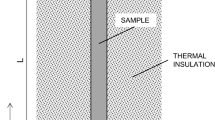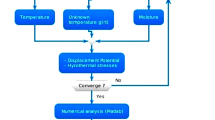Abstract
This article offers a study on estimation of heat transfer parameters (coefficient and thermal diffusivity) using analytical solutions and experimental data for regular geometric shapes (such as infinite slab, infinite cylinder, and sphere). Analytical solutions have a broad use in experimentally determining these parameters. Here, the method of Finite Integral Transform (FIT) was used for solutions of governing differential equations. The temperature change at centerline location of regular shapes was recorded to determine both the thermal diffusivity and heat transfer coefficient. Aluminum and brass were used for testing. Experiments were performed for different conditions such as in a highly agitated water medium (T = 52 °C) and in air medium (T = 25 °C). Then, with the known slope of the temperature ratio vs. time curve and thickness of slab or radius of the cylindrical or spherical materials, thermal diffusivity value and heat transfer coefficient may be determined. According to the method presented in this study, the estimated of thermal diffusivity of aluminum and brass is 8.395 × 10−5 and 3.42 × 10−5 for a slab, 8.367 × 10−5 and 3.41 × 10−5 for a cylindrical rod and 8.385 × 10−5 and 3.40 × 10−5 m2/s for a spherical shape, respectively. The results showed there is close agreement between the values estimated here and those already published in the literature. The TAAD% is 0.42 and 0.39 for thermal diffusivity of aluminum and brass, respectively.














Similar content being viewed by others
Abbreviations
- A:
-
Constant
- b:
-
Thickness of sample (m)
- Cp :
-
Specific heat (J/kg-K)
- d:
-
Probe diameter(m)
- D:
-
Sample diameter (m)
- H:
-
Heat transfer coefficient (W/m2 –K)
- Jo, J1 :
-
0th and 1st Order of first kind of Bessel functions
- K:
-
Thermal conductivity (W/m-K)
- L:
-
An operator for Finite Integral Transforms method
- M:
-
Mass of sample (kg)
- m:
-
Slopes of temperature ratio vs time curves, l/s
- n:
-
A characteristic number (n = 0 for infinite slab, n = 1 for infinite cylinder, and n = 2 for sphere)
- q:
-
Heat flux (w?m2)
- Q:
-
Rate of heat transfer (w)
- r:
-
Sistance from the center, m
- R:
-
Radius of an infinite cylinder or a sphere, m
- T:
-
Temperature (°C)
- Ti :
-
Initial temperature (°C)
- T∞ :
-
Medium temperature
- x:
-
distance from the center(m)
- α:
-
Thermal diffusivity (m2/s)
- ρ:
-
Density, kg/m3
- ϕ:
-
Dimensionless temperature ratio
- θ:
-
The temperature difference with ambient temperatures(T- T∞)(°C)
- ξ:
-
Characteristic length (m)
- λ:
References
Eric C., Husaini V., Reagins D., Singer M., (2008) Thermal Conductivity Experiments, Formal Report October–December.
Savija I, Culham JR, Yovanovich MM, Marotta EE (2003) Review of thermal conductance models for joints incorporating enhancement materials. J Thermophys Heat Transf 17:43–52
Tritt, T. M. & Weston, D. (2004) In Thermal Conductivity (ed. Tritt, T. M.) 187–203 (Springer US).
Hamilton RL, Crosser OK (1962) Thermal conductivity of heterogeneous two-component systems. Ind Eng Chem Fundam 1:187–191
Zeller RC, Pohl RO (1971) Thermal conductivity and specific heat of Noncrystalline solids. Phys Rev B 4:2029–2041
Borca-Tasciuc T, Kumar AR, Chen G (2001) Data reduction in 3ω method for thin-film thermal conductivity determination. Rev. Sci. Instrum. 72:2139–2147
Cahill DG, Goodson K, Majumdar A (2002) Thermometry and thermal transport in micro/nanoscale solid-state devices and structures. J Heat Transf 124:223–241
Mandelis, A., (1991) Progress in Photothermal and Photoacoustic Science and Technology Vol. 1 Elsevier.
Almond DP, Patel PM (1996) Photothermal Science and techniques. Chapman and Hall, London
Philippi I, Batsale JC, Maillet D, Degiovanni A (1995) Rev. Sci. Instrum 66(1):182
Welch CS, Health DM, Winfree WP (1987) J Appl Phys 61(3):895
He, D., Gu, Y., Zheng, M. and Zhu, D., (1996) 9th Int. Topical Meeting on Photoacoustic and Photothermal Phenomena, Nanjing (China), 1996, S.Y. Zhang Ed., Progress in Natural Science, pp. 169.
Yamane T, Katayama S, Todoki M (1996) Rev. Sci. Instrum 67(12):4261
Cernuschi F, Russo A, Lorenzoni L, Figari A (2001) Rev Sci Instrum 72(19):3988–3995
Parker WP, Jenkins RJ, Buttler CP, Abbott GL (1961) J Appl Phys 32:1679
Zawilski BM, Tritt TM (2001) Description of the parallel thermal conductance technique for the measurement of the thermal conductivity of small diameter samples. Rev Sci Instrum 72:1770–1774
Kennedy CA, White MA (2005) Unusual thermal conductivity of the negative thermal expansion material, ZrW2O8. Solid State Commun 134:271–276
Qiu L, Tang DW, Zheng XH, Su GP (2011) The freestanding sensor-based 3ω technique for measuring the thermal conductivity of solids: principle and examination. Rev Sci Instrum 82(4):045106. doi:10.1063/1.3579495
Qiu L, Zheng XH, Zhu J, Tang DW (2011) Note: non-destructive measurement of thermal effusivity of a solid and liquid using a freestanding serpentine sensor-based 3ω technique. Rev Sci Instrum 82(8):086110. doi:10.1063/1.3626937
Qiu L, Zheng XH, Su GP, Tang DW (2011) Design and application of a freestanding sensor based on 3ω technique for thermal-conductivity measurement of solids, liquids, and Nanopowders. Int J Thermophys 34(12):2261–2275. doi:10.1007/s10765-011-1075-y
Qiu L, Zheng XH, Yue P, Zhu J, Tang DW, Dong YJ, Peng YL (2015) Adaptable thermal conductivity characterization of microporous membranes based on freestanding sensor-based 3ω technique. Int J Therm Sci 89:185–192. doi:10.1016/j.ijthermalsci.2014.11.005
Qiu L, Li YM, Zheng XH, Zhu J, Tang DW, Wu JQ, Xu CH (2013) Thermal-conductivity studies of Macroporous polymer-derived SiOC ceramics. Int J Thermophys 35(1):76–89. doi:10.1007/s10765-013-1542-8
Anderson, B. & Singh, R.P. (2002) Air Impingement heat transfer on a cylindrically shaped object. The 1FT Annual Meeting and Food Expo. Presentation no; 9IC-22.
Erdogdu F, Balaban MO, Chau KV (1998) Modeling of heat conduction in elliptical cross section: II. Adaptation to thermal processing of shrimp Journal of Food Engineering 28:241–258
ASTM C714–72 (1972) Standard test method for thermal diffusivity of carbon and graphite by a thermal pulse method, ASTM.
BS7134: Section 4.2: (1990); Method for the determination of thermal diffusivity by the laser flash (or heat pulse) method. British Standards Institution
JIS R 1611 (1991) Testing methods of thermal diffusivity, specific heat capacity and thermal conductivity for high performance ceramics by laser flash method, Japanese Standards Association.
Carslaw HS, Jaeger JC (1986) Conduction of heat in solids. New York, Oxford
Erdogdu F (2005) Mathematical approaches for use of analytical solutions in experimental determination of heat and mass transfer parameters. J Food Eng 68:233–238
Rice, Richard G. & Duong D. Do (1995). Applied mathematics and modeling for chemical Engineers, pages 485–454; John Wiley & Sons Inc
Holman JP (2002) Heat Transfer, 3rd edn. McGraw-Hill
Jim Wilson (2007) Design, Materials, Compounds, Adhesives, Substrates, Number 3, Technical Data, Test & Measurement, Volume 13
KothandaramanCP, Subramanyan S (1977) Heat and mass transfer data book. 3rd edn. Wiley
Brown, Marco (1958) Introduction to Heat Transfer (3rd ed.). McGraw-Hill
Eckert; Drake (1959) Heat and Mass Transfer. McGraw-Hill.
Žecová M, Terpák J (2015) Article ID 753936) Fractional Heat Conduction Models and Thermal Diffusivity Determination. Mathematical Problems in Engineering 2015:9
Acknowledgements
The author is grateful to Fars Technological and Environmental Research Center and the Shiraz University of Technology for supporting this work.
Author information
Authors and Affiliations
Corresponding author
Rights and permissions
About this article
Cite this article
Talaghat, M.R., Jokar, S.M. Determination of heat transfer parameters by use of finite integral transform and experimental data for regular geometric shapes. Heat Mass Transfer 53, 3529–3544 (2017). https://doi.org/10.1007/s00231-017-2067-7
Received:
Accepted:
Published:
Issue Date:
DOI: https://doi.org/10.1007/s00231-017-2067-7




